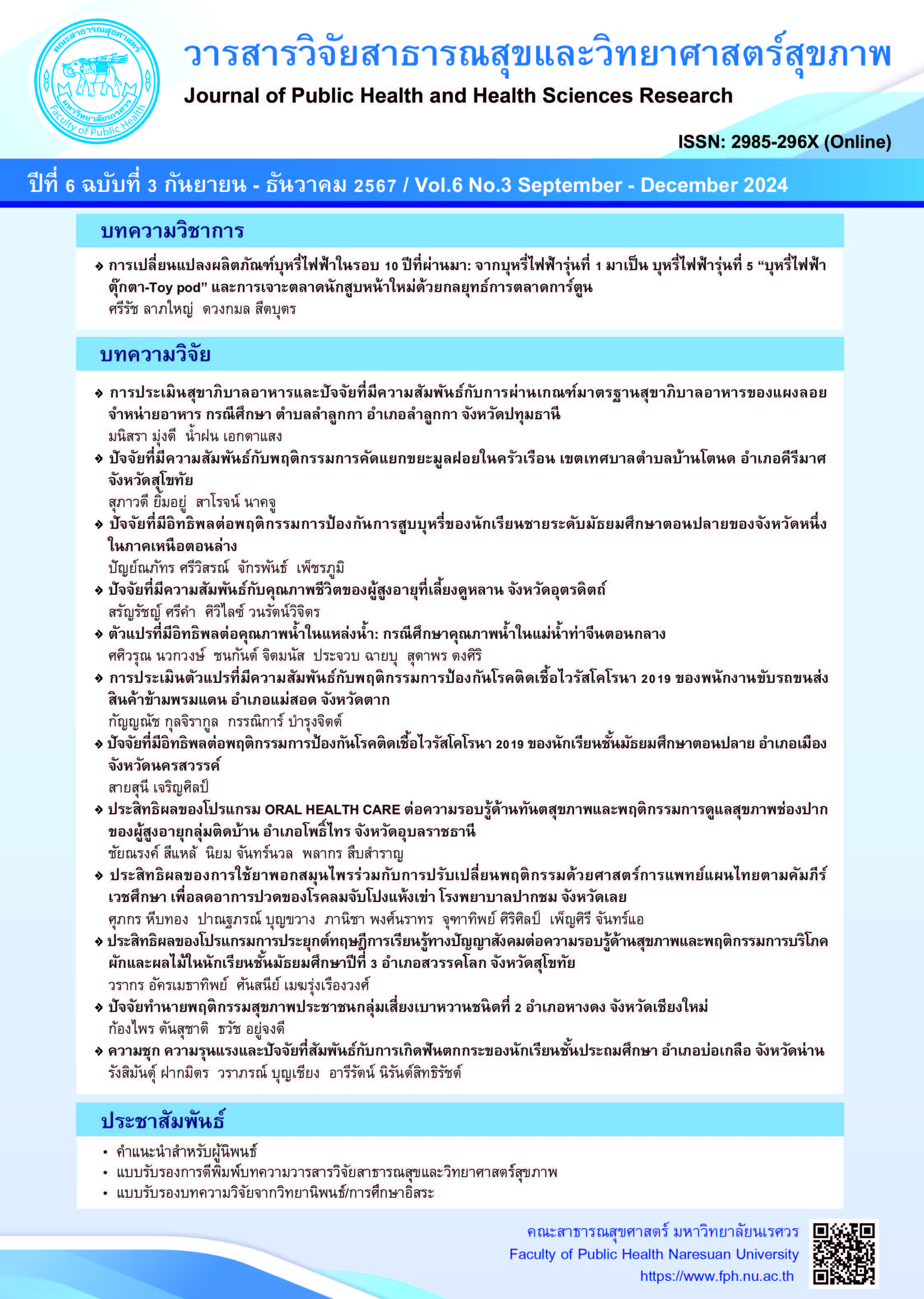E-cigarettes evolution over the past 10 years: from the generation to the 5th generation or "Toy pod" and cartoon-based marketing strategy targeting younger smokers
Keywords:
Cartoons marketing strategy, Young smoker, E-cigarette, Toy podAbstract
This article reviews electronic cigarette (e-cigarette) product development and marketing strategies. Due to the rapid evolution of electronic cigarettes in all aspects, particularly in product appearance and usage. The review found that the first-generation e-cigarettes (Generation 1), which resembled traditional cigarettes, also known as "Ciga-like", have evolved over approximately 10 years into the 5th generation e-cigarettes (Generation 5), which differ from all previous models. Tobacco companies have reintroduced cartoon marketing into the production, design, and promotion of these new e-cigarettes, resulting in devices that no longer resemble cigarettes. Instead, the new e-cigarettes are designed to look like dolls, toys, game consoles, beverage containers, stationery, and other children's items. These new e-cigarettes are small, colorful, flavored, and contain nicotine in a modified form for easier inhalation, with nicotine concentrations ranging from 3.0-5.0%. Cartoon characters are used in the marketing strategy, designing the devices to resemble toys and incorporating well-known or newly created cartoon characters into branding and storytelling. The 5th generation e-cigarette is referred to as the "toy pod."
The current situation found 436 online e-cigarette shops, with the majority operating on Twitter. The danger of this new generation of e-cigarettes lies in their indistinguishable appearance from real toys, combined with cartoon marketing strategies that make the product seem harmless to new smokers and increase accessibility. This article aims to raise awareness among parents and educational institutions to prevent and monitor the use of these new e-cigarettes and protect youth from using them.
References
Allem, J. P., Cruz, T. B., Unger, J. B., Toruno, R., Herrera, J., & Kirkpatrick, M. G. (2019). Return of cartoon to market e-cigarette-related products. Tobacco Control 28 (5), 555-557.
Baldassari, S. R. (2021). Electronic cigarettes: Past, present, and future. Clinic in Chest Medicine. 41(4), 797-807.
Berelson, B. (1952). Content analysis in communication research. New York: Hafner.
Berger, A. 2014. Media analysis techniques, 5th ed. Thousand Oaks, CA: Sage.
Calfee, J. E. (2000). The historical significance of Joe Camel. Journal of Public Policy & Marketing. 19(2), 168-182.
Collection cartoons. In Research into the impact of tobacco advertising. Stanford University. Retrieved January, 14, 2024 from https://tobacco.stanford.edu/ecigs/youth-targeting/cartoons/.
Cooper, M., Park-Lee, E., Ren, C., Cornelius, M., Jamal, A., & Cullen, K. A. (2022). Notes from the field: E-cigarette use among middle and high school students-United States. Morbidity and Mortality Weekly Report, 7; 71(40), 1283-1285.
DiFranza, J. R., Richards, J. W., Paulman, P. M., Wolf-Gillespie, N., Fletcher, C., Jaffe, R. D., & Murray, D (1991). RJR Nabisco's cartoon camel promotes camel cigarettes to children. JAMA, 266(22), 3149-53.
Dormanesh, A., Kirkpatrick, M. G., & Allem, J. P. (2020). Content analysis of Instagram posts from 2019 with cartoon-based marketing of e-cigarette-associated products. JAMA Pediatrics, 174(11).
Fadus, M. C., Smith, T. T., & Squeglia, L. M. (2019). The rise of e-cigarettes, pod mod devices, and JUUL among youth: Factors influencing use, health implications, and downstream effects. Drug and Alcohol Dependence, 201; 85-93.
Fischer, P. M., Schwartz, M. P., Richards, J. W., Goldstein, A. O., & Rojas, T. H. (1991). Brand logo recognition by children aged 3 to 6 years Mickey Mouse and Old Joe the Camel. JAMA, 266(22), 3145-3148.
Glantz, S. A., Barnes, D. E., Bero, L., Hanauer, P., & Slade, J. (1995). Looking through a keyhole at the tobacco industry: The Brown and Williamson documents. JAMA, 274(3): 219-224
Hafez, N., & Ling, P. M. (2006). Finding the Kool Mixx: How Brown & Williamson used music marketing to sell cigarettes Tobacco Control, 15(5), 359-366.
Jane Ling, M. Y., Abdul Halim, A. F. N., Ahmad, D., Ahmad, N., Safian, N., & Mohammed Nawi, A. (2023). Prevalence and associated factors of e-cigarette use among adolescents in Southeast Asia: A systematic review. International journal of environmental research and public health, 20(5), 3883.
Lapyai, S. (2023). Quarterly report 1/2023 E-cigarette and chewing tobacco in online platforms survey. (Research survey in Monitoring and Knowledge Management on Health Harming Products). Thai Health Promotion Foundation.
Thaikla, K. (2023). Monitoring e-cigarette shops in online platforms. Research Institute for Health Sciences, Chiang Mai University.
Kirkpatrick, M. G., Cruz, T. B., Unger, J. B., Herrera, J., Schiff, S., & Allem, J. P. (2019). Cartoonbased e-cigarette marketing: Associations with susceptibility to use and perceived expectations of use. Drug and alcohol dependence, 201, 109-114.
Kirkpatrick, M. G., Dormanesh, A., & Allem, J. P. (2022). Recognition of cartoon-based e-cigarette-related marketing is associated with e-cigarette use among adolescents. Addictive behaviors, 130, 107312.
Kirkpatrick, M. G., Dormanesh, A., Unger, J. B., & Allem, J. P. (2023). Cartoon marketing exposure decreases perceived risks of e-cigarette use in adolescents. Experimental and clinical psychopharmacology, 31(6), 1032-1038.
Ling, M. P., Glantz, A. S. (2002). Why and how the tobacco industry sells cigarettes to young adults: Evidence from industry documents. American Journal of Public Health, 92(6): 908-916.
Owotomo, O., & Walley, S. (2022). The youth e-cigarette epidemic: Update and review of devices, epidemiology and regulation. Current Problems in Pediatric and Adolescent Health Care, 52(6), 101200.
Ramamurthi, D., Chau, C., & Jackler, R. K. (2018). JUUL and other stealth vaporisers: Hiding the habit from parents and teachers. Tobacco control, tobacco control-2018-054455.
Tobacco Control Research and Knowledge Management Center. E-cigarettes in Thailand rose 10 times in 1 year. [Online]. 2023. Available from https://www.trc.or.th/th.
Wipfli, H. L., Kim, M., Vassey, J. & Stanton C. (2023). Vaping and anime: A growing area of concern. Tobacco Control, 32(6), 803-805.
Downloads
Published
How to Cite
Issue
Section
License
Copyright (c) 2024 Journal of Public Health and Health Sciences Research

This work is licensed under a Creative Commons Attribution-NonCommercial-NoDerivatives 4.0 International License.
The published article is copyrighted by the Journal of Public Health and Health Sciences Research.
The statements that appear in each article in this academic and research journal are the personal opinions of each author and are not related to Naresuan University and other faculty members in the university. Responsibilities regarding each article are the responsibility of each author.






